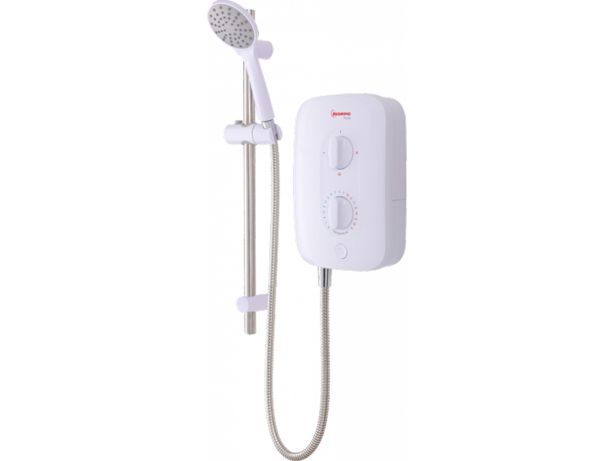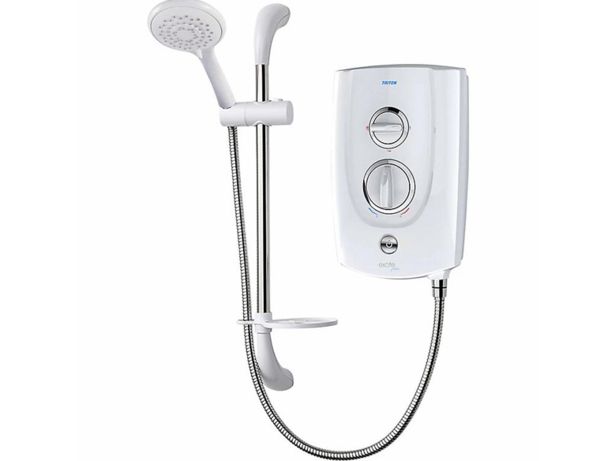By clicking a retailer link you consent to third party cookies that track your onward journey. If you make a purchase, Which? will receive an affiliate commission which supports our mission to be the UK's consumer champion.
Eco shower heads: everything you need to know

You might assume that taking a shower is more water-efficient than taking a bath, but that's not necessarily the case.
The electric showers we test typically have a water flow rate of around four litres per minute. At this rate, it would take around 10 minutes to fill a bathtub, whereas a more powerful mixer or power shower could easily fill a tub in five minutes.
An eco shower head, sometimes called a water-saving shower head, can be a great addition to a mixer and power shower, giving the feeling of higher pressure without actually using more water – meaning you can turn the dial down and save water.
Looking for a water efficient shower? Read our electric shower reviews to compare more than 70 we've tested
Are eco shower heads worth it?

An eco shower head can help save water and energy, which is good for both your wallet and the planet. Plus, they can still give you a refreshing shower experience without compromising on water pressure.
Eco shower heads control the flow and spray pattern of the water. They come in a range of shapes and sizes, and the design can directly affect water consumption.
Here are some things to consider before buying:
- To check whether you could cut your water usage, put a 2-litre container on the shower floor. If it takes less than 12 seconds to fill when the shower is running on full, that's the equivalent of it putting out 10 litres every minute. If that's the case, you could benefit from a low-flow or water-saving shower head.
- A large and fixed shower head can't be easily replaced with a new, more eco-friendly, head. It can also make a shower feel less powerful as the water is distributed over a larger area.
- Aerating shower heads mix water with air, reducing the overall amount of water that's needed.
- Other water-saving shower heads reduce the flow rate, 'pulsate' the water or include a flow regulator to the shower hose to save water.
Live more sustainably – get our free Sustainability newsletter to make changes for you and the planet
Which shower type is most water efficient?

- Bath and shower mixers - this is the type of shower where the hose and spray are attached to your bath. The temperature and amount of water are adjusted through the taps, giving you more control of the amount of water you use. This can be useful, as it gives you the freedom to reduce pressure and temperature, saving both energy and water.
- Electric shower - an electric shower is essentially a water heater, which rapidly heats cold water as it flows towards the shower head. Many have eco modes that reduce the pressure, saving both energy and water for when you don't need such a powerful shower. As part of our testing we try out every eco mode for the water flow and energy use. Our electric shower reviews reveal those with good eco modes.
- Manual mixer shower - this is a popular and cost-effective shower, where the hose and spray come out of a wall unit and there's a temperature control that mixes the hot and cold water supply. Depending on the pressure and temperature controls, it can be difficult to precisely and quickly adjust to save water and energy, so think about this before buying.
- Power shower - these use an electric pump that allows you to adjust the pressure and water temperature. This type of shower is the worst for water use and can quickly use more water than a bath.
Find out more about different shower types in our guide to how to buy the best shower.
Can you use an eco shower head with an electric shower?
Eco shower heads are usually not recommended for use with electric showers.
Eco shower heads fitted with an integrated flow regulator help you save water by restricting the water flow. However, restricting water flow can lead to water building up in the heater tank, causing the shower to overheat. For this reason, manufacturers often advise that you shouldn't use eco shower heads on an electric shower, as this could damage the shower unit. Contact the manufacturer if you're unsure.
Electric showers are already water efficient, so you shouldn't need to use an eco shower head with an electric shower anyway.
Where to buy an eco shower head
When shopping online, you'll see lots of eco shower heads on online marketplaces. When shopping online, not from a reputable seller, make sure to check their returns policy.
Popular retailers that stock eco shower heads include:
- Screwfix sells eco shower heads from Mira and Hansgrohe, ranging from £20 to £85.
- Amazon has a vast selection of eco shower heads, most of which are from small 'unknown' brands that use mineral beads, claimed to soften the water.
- Victorian Plumbing has a large range of eco shower heads from Mira and Hansgrohe, with some costing more than £200.
Discover which retailers are rated highly by Which? members with our expert guide on the best home and DIY shops
Water-saving shower gadgets

There are plenty of water-saving gadgets that time how long you're taking and the water you're using and alert you when you've been in too long.
Your water company may also supply free water-saving gadgets for your shower. These include:
- a shower-flow regulator that screws into the bottom of your shower hose
- simple shower timers in the shape of an egg timer that attach to your shower wall with a suction cup.
Check with your water company to see what freebies it offers.
Top water-saving tips for showers
1. Keep your showers under five minutes
Time them to see how long you typically take and use a water-saving timer that lets you know when you've exceeded 35 litres of water.
2. Don't leave your shower running
Try not to run your shower before you get in. If you can, keep your shower set at your preferred temperature so you don't have to spend time adjusting it before use.
3. Adjust your shower power
We all love a powerful shower, but think about if you can live with a less powerful one. Simply using a lower setting is one of the best ways to reduce your water and energy use.
For further advice, read simple tips to help you reduce your shower costs






















